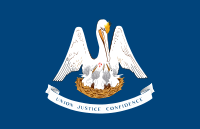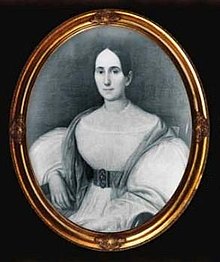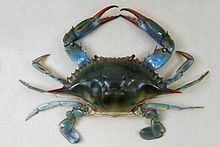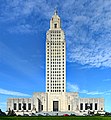Portal:Louisiana
The Louisiana Portal Louisiana (French: Louisiane [lwizjan] ; Spanish: Luisiana [lwiˈsjana]; Louisiana Creole: Lwizyàn) is a state in the Deep South and South Central regions of the United States. It borders Texas to the west, Arkansas to the north, and Mississippi to the east. Of the 50 U.S. states, it ranks 20th in land area and the 25th in population, with roughly 4.6 million residents. Reflecting its French heritage, Louisiana is the only U.S. state with political subdivisions termed parishes, which are equivalent to counties, making it one of only two U.S. states not subdivided into counties (the other being Alaska and its boroughs). Baton Rouge is the state's capital, and New Orleans, a French Louisiana region, is its largest city with a population of about 383,000 people. Louisiana has a coastline with the Gulf of Mexico to the south; a large part of its eastern boundary is demarcated by the Mississippi River. Much of Louisiana's lands were formed from sediment washed down the Mississippi River, leaving enormous deltas and vast areas of coastal marsh and swamp. These contain a rich southern biota, including birds such as ibises and egrets, many species of tree frogs—such as the state-recognized American green tree frog—and fish such as sturgeon and paddlefish. More elevated areas, particularly in the north, contain a wide variety of ecosystems such as tallgrass prairie, longleaf pine forest and wet savannas; these support an exceptionally large number of plant species, including many species of terrestrial orchids and carnivorous plants. Over half the state is forested. Louisiana is situated at the confluence of the Mississippi river system and the Gulf of Mexico. Its location and biodiversity attracted various indigenous groups thousands of years before Europeans arrived in the 17th century. Louisiana has eighteen Native American tribes—the most of any southern state—of which four are federally recognized and ten are state-recognized. The French claimed the territory in 1682, and it became the political, commercial, and population center of the larger colony of New France. From 1762 to 1801 Louisiana was under Spanish rule, briefly returning to French rule before being sold by Napoleon to the U.S. in 1803. It was admitted to the Union in 1812 as the 18th state. Following statehood, Louisiana saw an influx of settlers from the eastern U.S. as well as immigrants from the West Indies, Germany, and Ireland. It experienced an agricultural boom, particularly in cotton and sugarcane, which were cultivated primarily by slaves from Africa. As a slave state, Louisiana was one of the original seven members of the Confederate States of America during the American Civil War. (Full article...) Entries here consist of Good and Featured articles, which meet a core set of high editorial standards.
 Marie Delphine Macarty or MacCarthy (March 19, 1787 – December 7, 1849), more commonly known as Madame Blanque or, after her third marriage, as Madame LaLaurie, was a New Orleans socialite and serial killer who was believed to have tortured and murdered enslaved people in her household. Born during the Spanish colonial period, LaLaurie married three times in Louisiana and was twice widowed. She maintained her position in New Orleans society until April 10, 1834, when rescuers responded to a fire at her Royal Street mansion. They discovered bound slaves in her attic who showed evidence of cruel, violent abuse over a long period. LaLaurie's house was subsequently sacked by an outraged mob of New Orleans citizens. She escaped to France with her family. (Full article...) Selected article -Callinectes sapidus (from the Ancient Greek κάλλος,"beautiful" + nectes, "swimmer", and Latin sapidus, "savory"), the blue crab, Atlantic blue crab, or, regionally, the Maryland blue crab, is a species of crab native to the waters of the western Atlantic Ocean and the Gulf of Mexico, and introduced internationally. C. sapidus is of considerable culinary and economic importance in the United States, particularly in Louisiana, the Carolinas, the Chesapeake Bay, Delaware, and New Jersey. It is the Maryland state crustacean and the state's largest commercial fishery. Due to overfishing and environmental pressures some of the fisheries have seen declining yields, especially in the Chesapeake Bay fishery. (Full article...) General images -The following are images from various Louisiana-related articles on Wikipedia.
Did you know -
Related portalsTopicsCategoriesNew articlesThis list was generated from these rules. Questions and feedback are always welcome! The search is being run daily with the most recent ~14 days of results. Note: Some articles may not be relevant to this project.
Rules | Match log | Results page (for watching) | Last updated: 2024-11-22 21:09 (UTC) Note: The list display can now be customized by each user. See List display personalization for details.
WikiProjectsTasks
Associated WikimediaThe following Wikimedia Foundation sister projects provide more on this subject:
SourcesDiscover Wikipedia using portals |











































































